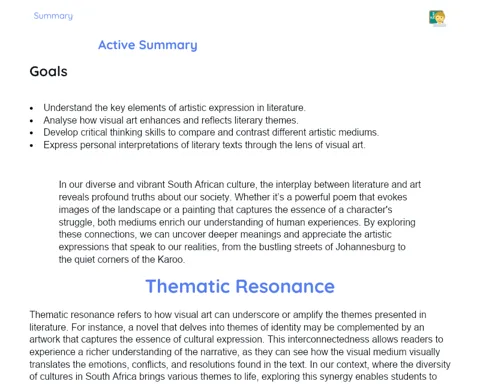Once upon a time, in the vibrant and bustling town of Mzansi, there lived a spirited young girl named Thandi. Known for her infectious laughter and vivid imagination, Thandi was a master storyteller among her peers. Every lunch break, students would flock to her under the sprawling shade of an ancient baobab tree—their meeting spot, known lovingly as the 'Story Hub'. This wise old tree, with its gnarled branches and wide, sturdy trunk, had heard countless tales, both of joy and sorrow, whispered by the winds that swept through its leaves. On this particular sunny afternoon, Thandi was determined to unveil the secrets of her storytelling prowess, focusing on the magical art of rhetorical devices.
"Hey guys! Do you want to hear a story?" Thandi called out, her eyes sparkling with excitement as she gathered her friends around. As her friends settled down, curiosity sparkled in their eyes, she continued, "Let’s explore how we can make our stories more engaging!" She began with her favorite rhetorical device, the humble yet powerful anecdote. "Have you ever found yourselves lost in an adventure?" Thandi asked, drawing her friends closer. With a mischievous grin, she dove into a memorable incident: the time she accidentally wandered off at the Johannesburg International Airport, mistaking a duty-free shop for a magical land filled with chocolate fountains and toy stores. Her friends erupted with laughter, visualizing her bewildered expression as she tried to navigate the bustling airport. This lively tale resonated with them, showcasing how personal stories could captivate and engage an audience from the very first moment.
Thandi's friends leaned in closer, their imaginations alight with possibilities as she reached the crux of her story. With a dramatic flair, she paused mid-sentence, raising an eyebrow as she asked, "But wait! What do you think happened next?" This clever use of a rhetorical question left them in suspense, their hearts racing with anticipation. She explained that such questions create a bridge between the storyteller and the listener, inviting them to participate in the narrative rather than passively absorbing information. This was an important lesson: engaging your audience could elevate a simple story into an unforgettable experience. They began to brainstorm how they could incorporate this technique into their own school assignments and presentations, igniting a creative spark among them.
With the sun casting a warm, golden glow and a gentle breeze rustling the leaves, Thandi shifted the conversation to introductions and conclusions—the bread and butter of any compelling story. "Think about a bunny chow, guys!" she exclaimed, a smile spreading across her face. "The introduction should whet your appetite, making you want to dig into the delicious filling, while the conclusion should be like the last bite—satisfying and memorable!" Her friends nodded in agreement. Thandi urged them to weave their anecdotes and thought-provoking questions into these crucial sections, ensuring that their stories began and ended in a way that resonated deeply.
As the shadows of the baobab tree began to stretch with the setting sun, Thandi's friends felt their hearts swell with determination and creativity. They made a pact to experiment with rhetorical devices in their upcoming English class, sharing personal anecdotes that mattered to them and posing questions that would provoke curiosity and thought. As they wandered home, the excitement coursed through their veins, fueled by the promise of mastering storytelling just like Thandi. That day, under the watchful gaze of the old baobab, the seeds of creativity and rhetorical prowess were sown, creating a ripple effect that would weave its way throughout the classrooms of Mzansi, one captivating story at a time. The adventure of learning had just begun, and they were ready to tell their tales.

